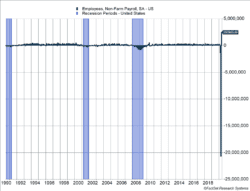The jobs market rallied back far sooner and stronger than expected. The U.S. economy created 2.5 million new jobs in May. Economists had projected a loss of 7 million jobs, so the surprise was massive. The gains are mainly attributable to workers who were temporarily laid off being called back to work as lockdowns ended or were relaxed.
Key Points for the Week
- The U.S. economy added a record 2.5 million jobs in May.
- U.S. exports dropped 20.5% and imports slid 13.7% as global economic weakness pushed trading lower.
- The S&P 500 added another 5.0% last week and is barely negative for the year.
The European Central Bank (ECB) announced plans to continue to buy bonds in order to promote liquidity and economic growth. The ECB is now on par with the Federal Reserve for how much support it is providing its economy. The global economy continues to wrestle with declining trade. U.S. exports and imports both dropped double digits last month.
Stock investors viewed economic data very positively and pushed stock indexes higher. The S&P 500 gained 5.0% last week and nearly turned positive for the year. Global stocks welcomed the news of additional economic stimulus as the MSCI ACWI soared 5.8%. The Bloomberg BarCap Aggregate Bond Index dipped 0.5% as improved growth pushed long-term interest rates higher. Bond prices move in the opposite direction of interest rates.
The Federal Reserve meets next week. We are often asked whether we expect the Fed to lower rates below zero or announce other measures to stimulate growth. Our expectation is the Fed will not lower rates below zero now or in the future. Countries with negative rates haven’t seen strong gains in economic growth or in their stock markets. Central banks have plenty of tools available that will have more effect. Of particular interest is a program already announced to help mid-sized businesses. Helping those companies get through the slowdown and spurring rehiring is a key goal as Americans seek to revive the economy.

Missed It By That Much
May’s jobs report was full of positive surprises. As shown in the nearby chart, the economy produced 2.5 million new jobs, trouncing economists’ expectations that it would lose seven million jobs. Rather than rising to nearly 20%, unemployment dropped to 13.3%.
Put another way, economists projected the second largest monthly job loss in history and the economy experienced the largest gain instead. It brings to mind fictional secret agent Maxwell Smart, who would gesture to imply the results barely missed expectations and utter, “Missed it by that much” when faced with evidence of a wide gap between his expectations and reality.
Roughly half of the gains were tied to restaurants, which brought back 1.4 million workers. Many states had begun easing lockdown restrictions, and the reopening of restaurants brought back about 15% of the losses the broader leisure and hospitality segment experienced in April. Construction jobs increased nearly half a million, and health care jobs increased nearly 400,000 as dentists and other providers of mostly elective services brought back staff.
The jobs report is supporting optimism the economy has bottomed and will recover faster than originally expected. The surprising swing upward was likely due to a number of factors working together to push employers to bring workers back:
- States eased lockdown restrictions allowing more business activity.
- The Payroll Protection Program and other support packages are limiting job losses and causing some workers to be rehired.
- By the week of May 10, when the survey was completed, new coronavirus cases were declining and consumers were ready to venture out.
The unquestionably positive report establishes the economic bottom came in April and the economy has initially proved more resilient than expected. Underneath the topline numbers are a few key underlying trends we are watching closely. The most important is whether workers’ expectations that layoffs will be temporary hold true. In April’s report, 78% of the unemployed believed their situations were temporary. That proved true for roughly 2.7 million workers called back to their jobs, and now 73% expect to be called back.
Of course, temporary job losses can become permanent. The number of permanent job losses increased by roughly 300,000 in May. State and local governments also continue to reduce employment in order to protect their badly damaged budgets. The loss of sales tax revenue and other income led to the layoffs of nearly 585,000 state and local government jobs. We expect the federal government to pass some additional support for state and local governments in coming months, although the looming election will complicate any additional packages.
The rally in the job market has improved our outlook for the economy. The economic bottom reached in April is expected to hold, and the initial bounce back, which we anticipated in June, came early. Because the absolute bottom wasn’t as deep as expected, the long-term economic damage will likely be lower.
In order for the rapid increase in economic activity to continue, the U.S. needs to see declines in the number of coronavirus cases. Instead, the number of cases has plateaued just above 20,000 per day. The global trend in new cases is decidedly worse. Brazil has become the epicenter of the virus spread, and global new cases are at all-time highs. This month’s trade data showed exports plunged 20.5%. These numbers will likely improve in future months, but a rapid recovery needs greater economic activity across the globe in order to sustain high growth.
—
This newsletter was written and produced by CWM, LLC. Content in this material is for general information only and not intended to provide specific advice or recommendations for any individual. All performance referenced is historical and is no guarantee of future results. All indices are unmanaged and may not be invested into directly. The views stated in this letter are not necessarily the opinion of any other named entity and should not be construed directly or indirectly as an offer to buy or sell any securities mentioned herein. Due to volatility within the markets mentioned, opinions are subject to change without notice. Information is based on sources believed to be reliable; however, their accuracy or completeness cannot be guaranteed. Past performance does not guarantee future results.
S&P 500 INDEX
The Standard & Poor’s 500 Index is a capitalization-weighted index of 500 stocks designed to measure performance of the broad domestic economy through changes in the aggregate market value of 500 stocks representing all major industries.
MSCI ACWI INDEX
The MSCI ACWI captures large- and mid-cap representation across 23 developed markets (DM) and 23 emerging markets (EM) countries*. With 2,480 constituents, the index covers approximately 85% of the global investable equity opportunity set.
Bloomberg U.S. Aggregate Bond Index
The Bloomberg U.S. Aggregate Bond Index is an index of the U.S. investment-grade fixed-rate bond market, including both government and corporate bonds
https://www.worldometers.info/coronavirus/
https://www.worldometers.info/coronavirus/country/brazil/
https://www.worldometers.info/coronavirus/country/us/
https://www.wsj.com/articles/may-jobs-report-coronavirus-2020-11591310177
Compliance Case: 00748509


